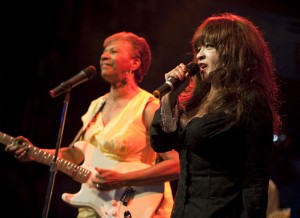I’ve long contended that the worst art isn’t the most inept; it’s the most forgettable. The levels of craft may be worlds apart, but Ed Wood films are as entertaining in their way as Scorsese movies, and both are better than yet another mismatched buddies action movie. The Ponderosa Stomp this weekend was a first class reminder about the value of idiosyncrasy as artists who in some cases only had one “hit”— Tommy Brown, for example—were stand-outs despite having semi-obscure recording careers. Brown’s an R&B singer—which, he explained during an interview at the Ponderosa Stomp Conference, meant two different kinds of songs, rhythm songs and blues songs—known for “Weeping and Crying,” a blues that he mock-sobs his way through that I first heard on a K-Tel novelty collection. When he rehearsed the song with Los Po-Boy-Citos the day before, he told them, “Whatever I do, keep playing,” and during his performance, he threw himself to floor with disturbing intensity, and the next day at the conference he spoke of taking falls into the audience including one years ago when he took a fall from a balcony.
Musically, Brown wasn’t terribly distinctive; if you don’t know him or remember him, it’s not like you’ve missed out. He eventually developed a career as a comedian and recorded some of the first “party records,” and his sense of humor animated his songs and his performance. He revisited an age of randy, well-told jokes and the guilelessness of his delivery obliterated any sense that something anachronistic was going on.
Thee Midniters promised to be similarly, charmingly nutty. Earlier in the day at the Conference, bassist Jimi Espinoza was a live wire, singing songs as he mentioned them, seemingly over-caffeinated and under-filtered, but the lineup for the garage band from Los Angeles had been filled out with younger musicians that played rock versions of the R&B hits of yesteryear, songs that are such oldies staples that there’s little buzz in them. It’s what garage bands did, and it’s one of the reasons garage bands are hit-and-miss at the Stomp, but another well-performed, reverent version of “Everybody Needs Somebody to Love” is one thing the world doesn’t need.
Eccentricity didn’t always come through being blissfully out-of-time or out of touch. The Relatives‘ set of gospel funk from the mid-1970s didn’t show any signs of rust, and they’d be dazzling in Jazz Fest’s Gospel Tent. Live, the sound wasn’t as fuzz-drenched as on their Don’t Let Me Fall album—which recalls the “Ball of Confusion”-era Temptations—but the aggressive, wah-wah and percussion-driven funk was as physical and compelling as any heathen funk.
What we look for in the arts are signs of life, whether its found at the Stomp in the Relatives, Duane Eddy, Barbara Lynn or Ronnie Spector (who made an unannounced appearance)—people who defined or kicked at the boundaries of genres—or Brown and countless others who found a framework for their eccentricities in musical genres. The Crystals’ LaLa Brooks still played the sex kitten in her early 60s, slamming her hips around Friday night like a stripper in search of a pole; the next night, Sugar Pie DeSanto made her look like a librarian. As icky as sex between AARP card-holders is to imagine, there’s no denying that their displays were charming and encouraging. We all want to live long enough and sexual enough to make younger generations go “euuugh” when we’re that age.
Possibly the most rock ‘n’ roll moment of this year’s Stomp didn’t come from a musician at all. Jim Russell’s history in radio and the record industry dates back to the early 1950s, when he co-produced some of the early rock ‘n’ roll shows in Brooklyn with Alan Freed. I was scheduled to interview him as part of the Stomp Conference, but he told me and organizers that he intended to start with a statement, one that would tell people how to make money. What followed was an exercise in pure personality—45 minutes that were part Little Richard, part Grandpa Simpson, part infomercial shill. He touched lightly on his role in making sock hops a way to break artists, and he spoke of his use of a ratings system he devised to do it. On one hand, it seemed like another anachronistic moment, speaking to a kind of radio that really doesn’t exist anymore, but the larger idea – develop a way to quantify human activity and act based on the results of that information – has become the basis of an industry in recent years. Along the way, he lectured, told corny jokes, spoke German, demanded hugs and held court as someone who knew he wasn’t going to get a lot more chances to say what he wants to say to an audience. As an oral history, it was maddening. As a performance, it was genius, and the sort of display that makes the Ponderosa Stomp so fascinating.





